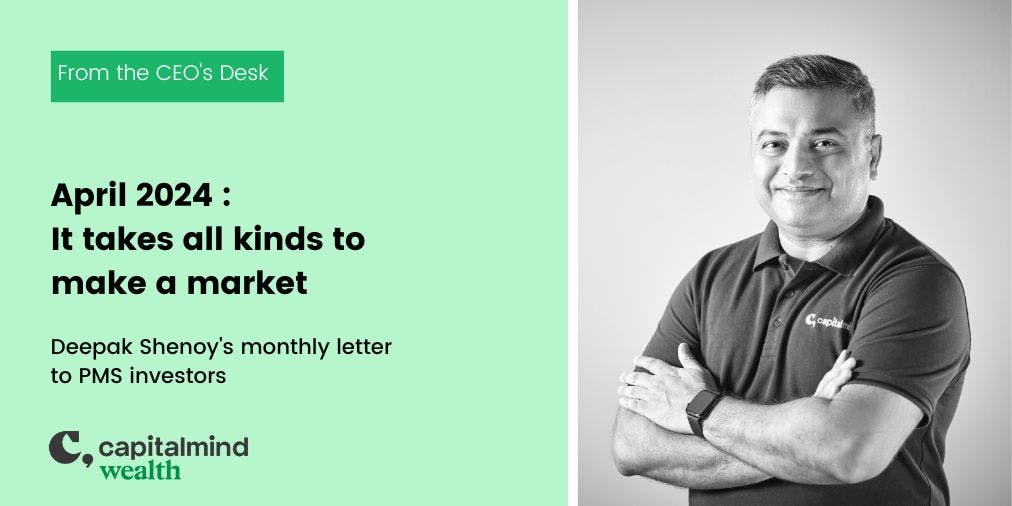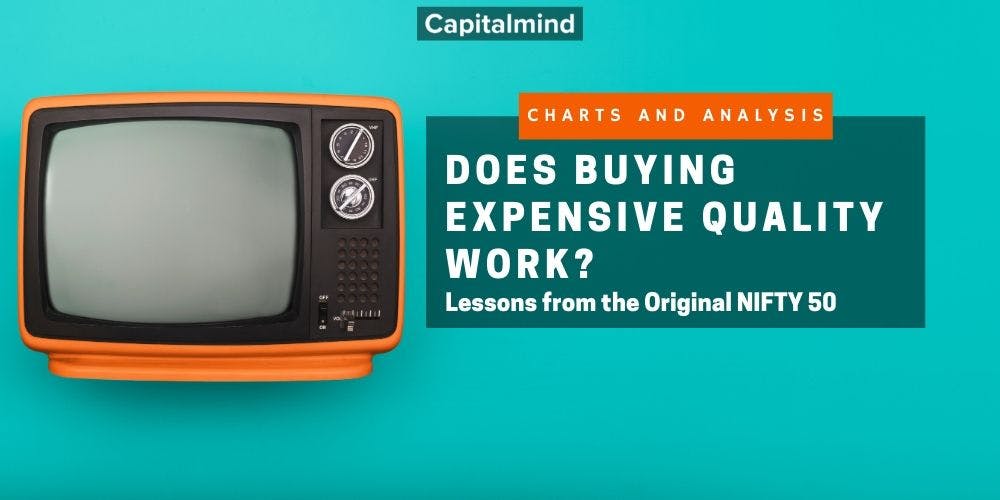(category)Deepak's Memos
It takes all kinds to make a marketIt takes all kinds to make a market
Deepak Shenoy•

Market returns are a function of cycles and we tend to ride the ups and downs alongside. All we need to do in the long term is to survive the downs and aggressively outperform on the ups. That means portfolios must go down, and it’s because they can go down, is what gives them the ability to soar.
This is non-intuitive, sometimes. Can’t we be up on the downs, and stay up on the ups? Isn’t that what portfolio management is about? The answer, sadly, is no. In fact, the more “smooth” the upward looking curve is, in the short term, in a volatile market, the more suspicious you should be of it.
Amber Dalal is the latest story in Mumbai, and he defied this law for 12+ years. A Chartered Accountant, Dalal told people that he would offer them 1.5% a month for their money, paid via bank transfer to their accounts. For more than a decade, he would send this 1.5% back, spot on, month after month, on roughly the 10th of every month. Sounds too good to be true?
Come March 2024, it was. After defaulting on the monthly payment, Dalal just vanished. He was found a couple weeks later in a Dehradun resort, and arrested. The police is trying to find out what happened, as are investors who gave him more than 500 crores.
This might be a ponzi scheme, where Dalal simply raised more money to pay off investors. All you have to do really is to have more funds raised every month and if you pay people in their bank accounts, they won’t complain. The problem is only when they want their money back, which might have happened in the March 2024 timeframe.
This might also be a set of trades gone horribly wrong. Dalal said he’d do commodity futures arbitrage, and indeed, there have been opportunities using futures and options that would have been able to provide a decent income for a while. But like all opportunities, when enough people find out about them, they might come and crimp those margins by aggressively bidding up prices or selling lower. The 1.5% soon becomes a 1%, and then a 0.75% and so on. I’ve seen a fair bit of these cases myself, but in all of them there is a common thread: the trader increases leverage to try and make the higher return. Meaning if he would trade a 100 contracts, and the profit falls to 0.75% a month, he increases his position to 200 contracts to make his 1.5%. This might succeed a few months and he tells himself the dialogue that you should simply never say: Apun hich bhagwan hai. (Loosely translated, I’m God)
This phenomenon, now perfected by the US federal reserve in the form of multiple quantitative easing (QE) mechanisms, has a problem when you do not have the printing press that the Federal Reserve has.
When there is a bout of volatility in the market, your “double” leverage hits you badly. Commodities are heavily leveraged, so a small profit can be magnified (1% can be made into 2%), but small losses will also become much larger. In the chase of a “fixed” return, you can expose yourself to ruin. A large enough move against you can wipe your capital down to zero. And then, your guaranteed 1.5% per month can’t be honoured.
That could have been Dalal’s fall, though we don’t know yet.
As an investor, be suspicious of very high “steady” market returns. In the short term, the markets are volatile. They are required to be. If someone offers you a very high “fixed” return, with no downside, you’re signing up for something that has the risk of complete ruin. Dalal said he was investing in commodities, which are inherently volatile. And yet, a regular 1.5% a month? There is something black in the mulligatawny, as the British would have translated a common Hindi saying.
Last year at the same time, we wrote a little letter titled: The fresh air in all this despair. A lousy time for markets, but we were quite optimistic about the times to come. And that time, indeed is here - even the Nifty has delivered 30%, and the Nifty 500, about 40%.
We continue to be positive on the markets. Much was made of the recent “downturn”, which was more like…you know that weird feeling you get before you sneeze, and then the sneeze doesn’t actually happen? More like that. You could say that it’s indication that a big sneeze is coming and you’re going down with something. You could also say that it was a fraud sneeze and nothing’s going to happen. You would be right in either saying at different times. We’re unlikely to be a good judge of the implication of an imperfect sneeze, or a wobbly market.
But the questions do come, and perhaps the most common thing we hear is: Will midcaps and smallcaps do badly now, and largecaps do better? Will Capitalmind shift our allocation to mid and small caps after this stellar performance of midcaps?
Here’s what I think. Sometimes, a market participant has to say something just to show the world he’s still breathing. I’ve done it, myself, to sound more intelligent than I am. The midcap rally is over, I might say, and this will be the year of the large caps. Because, well, because midcaps and smallcaps have done well, now it’s the large caps' turn, surely?
There are many problems with this. First, no one knows. The market doesn’t give equal opportunities based on market cap. Second, smallcaps will turn into midcaps as they grow, so if you’ve picked a good stock, it might traverse the cap journey. You will still make money on it, but just be more allocated to mid or large caps when you do.Third, a single year or two is not going to make any difference in your long term journey, so why bother making decisions of reallocation based on a year’s performance? Fourth, and in case you missed it, no one knows.
There will be people who will make money as small cap investors even if smallcaps hurt. Case in point: BSE is a midcap, and fell 20% in March. It is back up 40% from the lows, at much higher levels than earlier. It’s in two portfolios and we entered when it was a smallcap. The story repeats with enough mid and small caps for people to have varying results in their actual portfolio.
It takes all types to make a market. You will have the speculators, the traders, the investors, the buy-and-holds, the buy-and-forgets, and the churn-and-burn, etc. All of these options - whether they are value, momentum, growth, earnings, quality or any other investing profile - can make serious amounts of money. You can churn and make money. You can hold and make money. As you gain experience, you realize there are many paths to financial success, and you can choose any one, without disdain for the others. There’s no “better” way, even if they tell you that churning stocks is bad or such.
A story in that context, to bring this to a close. I was in Bangalore when a friend gave my wife and me some tickets for a “cognac tasting” session. We were relatively uninformed at the time, but it was free alcohol, which is acceptable to a young couple with no kids. So we went. A person of British origin was anchoring the session, having us taste various Hennessy brands, like VS, VSOP, XO etc.
He’d ask us questions like:“What does this taste like?”
And my mind was saying, “alcohol”, but we felt too desi to just say that. Someone else said “woody” so we quickly agreed that woody was correct.
It went on like this for a while, and we went from woody to peaty to flowery to what not, and we felt a little illiterate even while we were winging it on the taste metrics. Then, someone asked:
“What do you pair a good cognac with?”
Now the British often come across as a little snooty, but something in the manner of this man changed.
“Let me tell you a story”, he said.
“Long back, we found that the most expensive Hennessy cognac was seeing the maximum sales from a little town in Texas. I was asked to investigate. I visited the largest shop in the area, and they told me it was a single buyer, who’d buy cases and cases of the $10,000 per bottle cognac. In fact, he said a new set of cases was going out today, so I waited.
The customer came in, a old Texas rancher, in a limo. As his car was getting loaded with the cases of, remember, $10,000 a bottle cognac, the customer asked to open one case, and took a bottle from it. He poured himself a drink into a glass, and asked his driver to get him a Coke to mix it with.
A coke. To mix with the most expensive French cognac our company made. It is that day that I realized the ultimate Hennessy salesperson’s lesson.
It doesn’t matter what you mix it with. Just enjoy it the way you like it.”
At that instant, I was thankful I didn’t have to live with understanding the differences between woody and peaty and fruity. It doesn’t matter.
There are many ways to make wealth from the markets. It takes all types. You don’t have to be one type. You don’t have to belittle anyone that makes their money a different way from yours.
This applies to life, too, in some way; at the core of financial happiness is a word that you ask other people about, but you know it’s ultimately yours to decide: how much is “enough”?
(For this letter, we’ve found the answer: it ends here.)
Here’s to a fantastic FY25!
Deepak
Related Posts
Make your money work as hard as you do.
Talk to a Capitalmind Client AdvisorInvesting is not one size fits all
Learn more about our distinct investment strategies and how they fit into your portfolio.
Learn more about our portfoliosUnlock your wealth potential
Start your journey today




